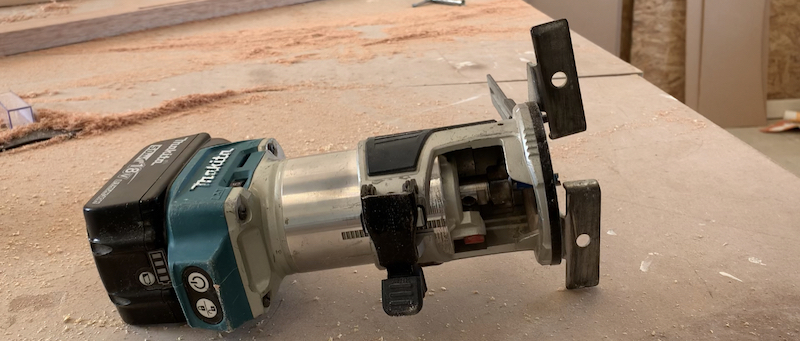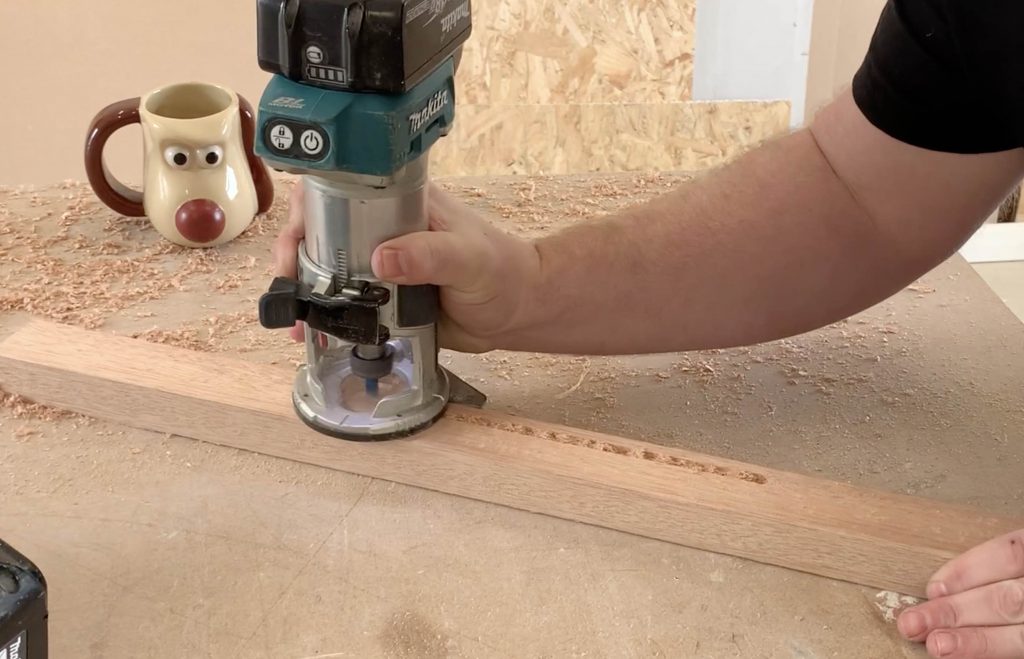Following on from having a sticky collet and replacing a router cutter I thought it would be worth showing you guys how to use a cordless trim router and what it’s best applications are. Amazingly cordless tools are just so far ahead of the game now.
Table of Contents
So after using my cordless routers for the last three years I thought I would put together some good do and don’ts that’ll make your experience much more straightforward. Some are astoundingly obvious but so easily overlooked 😀
Here’s a demo of me using and talking about the power of the best cordless router
Here’s a link to that demo of the cordless router for mobile viewers
What can you do with a cordless router?
I use my cordless router for hinges, locks, latches, seals in doors, round overs, and a load of other light weight stuff that once upon a time I wouldn’t have dreamed of due to the restriction of a power cable 🙂
Are cordless routers any good?
For the applications mentioned above cordless routers are literally a gamer changer. I literally would not head to site now without my cordless router. I would have a very difficult and bad day without my cordless kit in general, in fact, I don’t even think I would bother working. That’s not just how good cordless routers are, but how essential they’ve now become to my setup and almost every single site chippy up and down the UK.
It’s not just site work either. DIY enthusiasts will benefit from cordless trim routers. They are practically tailor made for the smaller job DIY enthusiasts are likely to have a go at (hanging doors – cutting hinges out, locks, flush cutting materials, rounding over edges, and so on).
Keep your batteries fully charged
I’m starting with one that should make you close the page but you won’t. Why? Because how often do you go “oh s***” I forgot to charge that – me too 😀 However on the trim router this is a problem. I notice a loss of power almost straight away when I drop under two bars on my Makita cordless router and it’ll begin to stall quite quickly as a result. I then lose confidence in the cut speed and slow down because I begin to worry about a stall.
The problem isn’t the stall itself, the problem is the fact you jump, and if you get a kick the wrong way you damage face edge exposed timber which is really annoying. Don’t get me wrong, if you’re doing heavy work with one of these little routers you can still stall, but at least give yourself half a chance with a full battery 🙂
Make sure your router cutter is really sharp
What your machine lacks in power, you need to make up for by ensuring everything else is up to scratch. That means, the batteries we just discussed and a super sharp router cutter. What I would say is, don’t push so hard through your timber or you’ll dull the blade quite quickly, especially on hardwood. I know this is annoying but you don’t want to be replacing cutters all the time. The other thing is buy a quality cutter. When I am machining old doors I have no choice but to buy cheap. I don’t think I could bear to lose an 8mm straight flute trend cutter fitting a fire seal on a door.
If however I am using a new door or casement, I will go with a quality trend cutter all day long. Now you would probably not be surprised to hear I can literally feel the difference in the cut and I can also see a much crisper cut on the timber itself too. Router cutters are not equal at all. The rubbish I use to cut doors for a few quid from tool station cannot compare to a thirty quid trend router cutter!
Secure your router cutter firmly
Obviously you need to make sure the router cutter is secured firmly. It’s an easy mistake to make – if you don’t the cutter will begin to slip out and you’ll notice your cut getting deeper and deeper. I know this unfortunately from personal experience 😀 It’s always just checking how firm your lock is on the collet before cutting.
A top tip here is to engage the shaft lock, and then begin to tighten the collet. This will ‘pinch’ the shaft lock and now you can focus on applying full pressure to the collet and really securing your cutter. Be careful though, you don’t want to end back on my page ‘how to remove a stuck router cutter’ 😀
Setup the guide and fence and make sure they are tightened firmly
Really basic stuff but make sure you tighten up the fence well. On the Makita cordless router you only have one point of tightening. This is both good and bad. It’s good because you can adjust the fence super quick, it’s bad because one fail point and you’re slipping. That puts far more importance on ensuring your router fence nut is as tight as possible.
Consider using a dust extractor
Once you get confident with your cordless router then it becomes about health. If you can get hooked up to a router extractor then poisonous timber should be caught way before your mask. I’m not saying don’t wear a mask with an extractor, I’m just saying it’s much better to take the timber or as much of the timber dust out of the air as possible in the first place. This is especially good practise if you’re working in a house that is being lived in.
The other benefit of an extractor is the clean cut. I notice the grooves clear up much better when material is being sucked away. This obviously doesn’t make much of a difference if you’re using a round over for example and I can certainly appreciate that this will be a problem if you’re chopping in a door hinge without a jig so it’s not a must.
Do you push or pull a router?
Luckily the way the trim routers are made it’s impossible to set up the router the wrong way. If you try to pull the Makita cordless router towards you then chances are you’ll run off the timber and make an awful mess of that face edge. The router is designed to be pushed away from you and the router will hold you on a straight course this way. Don’t follow this advice at your peril, it’s probably the most important piece of information in this article so far on how to actually successfully use a trim cordless router.
Fixed base or plunge base?

Basically you get two types of bases on a cordless trim router. One is a base that simply locks and you need to turn off the router to adjust heights safety. The other is a plunge base. The plunge base is designed so you can safely change depths whilst machining. The Dewalt cordless router is probably the best for this actually. Despite being the largest of the small cordless routers, I really like the feel and how well you can use their plunge base.
